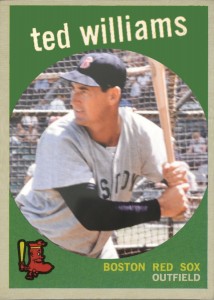Talkin’ Baseball
Walking Ringo the dog this morning on the South Common, I think baseball came into my head because the sky was bright and sun promising on a day that feels like the start of summer. I had been looking at vintage baseball cards online earlier. I don’t buy cards online, but I like to look at the real “holy pictures” of my youth. As in countless other households, there was a fateful day in the past when a couple of shoe boxes filled with small cardboard treasures were tossed in the trash. One of the baseball players that came to mind today is Ted Williams. Maybe because it is Memorial Day, I was remembering the special 1959 Fleer brand Ted Williams card set that included at least one image of him as a pilot: he flew combat missions in Korea for the US Marines. These days, not many professional athletes serve in the military. It’s a rarity to find a volunteer in the NFL, NBA, NHL or in Major League Baseball. Ted Williams was in my brother David’s era, who is five years older than me. I caught the end of Williams’ years with the Red Sox as a little kid, but the Sox didn’t really come into focus for me until Carl Yastrzemski replaced Ted in left field at Fenway. The first year I collected baseball cards seriously was 1964; my brother David had cards going back to the late ’50s. He had nearly all the cards in the special Ted Williams set of 1959. We never had the card shown here. What a beauty. Nobody had the card. It didn’t exist. This is a fantasy card made by a guy named Uncle Doc in San Diego (uncledocscardcloset.com). He’s a high-end collector and has a sideline of making cards that never were. While Topps was the standard for baseball cards during the ’50s and ’60s, you won’t find a Ted Williams card from 1959. Doc speculates that Williams signed an exclusive deal with Fleer for the special Ted cards, which blocked Topps from having him in the annual set.
When I was growing up, the traditional Memorial Day backyard barbecue at the home of my Brady cousins in Centralville would often include a sprawling baseball game with fathers, sons, and a few daughters picking up teams across the street at Hovey Park on Aiken Avenue, behind Ouellette’s Funeral Home. The infield was measured for little league games or softball with the pitcher’s mound closer than on a regulation baseball diamond, as I recall. Many years later, I played on a couple of men’s softball teams that used the field, but the game was always baseball when we were kids. My cousins Tommy and Danny and I would spend whole afternoons playing home run derby, taking turns at bat and playing outfield—hitting the ball out of our hands as we tried to smack the ball over the head of the fielder and into the tall grass beyond right field (the center field wall was about 500 feet away, and left field merged into the right field of the second ball field at the other end of the park). Right field was the only chance for what looked like a home run. I must have caught thousands of fly balls in that park over the years. We didn’t think of it as practice. We were having fun. But that kind of repetition is the only way that catching becomes second nature. At some point you just know the ball is going to go into your glove. You don’t have time to measure angles or inches. You stick your glove up, and the ball goes in. Your eyes track the ball, and your body flows to the flight of the baseball. It’s an amazing thing when ball and glove connect.
One of my best memories of hitting a baseball was a day when I was high-school age and living in Dracut. It must have been a summer day. I had walked up Janice Avenue, which ran alongside the house I grew up in, with about six kids from the neighborhood, headed for one of the farm fields at the top of Janice (on maps the area is called Winter Hill, and house contractors called the area Crosby Heights for Crosby Road that ran parallel to Janice, connected by three cross streets). When we got to the field, over a rock wall behind the back yard of a house on Gloria Ave., one of the kids said, “I’ll pitch to you, and we’ll have fielding practice today.” The field was a meadow on which we had worn base paths and put pieces of plastic or squashed boxes for bases and home plate. For the next hour I stood at the plate and pounded fly balls and line drives to left, right, and center. The fielders ran around like crazy, making routine and spectacular catches, diving to stop balls from going into the woods, pulling in high flies, and throwing the balls back in to the pitcher. I felt like I had won the lottery, getting to swing and hit until my arms ached. To someone who has not played baseball, it’s difficult to explain the physical satisfaction felt in driving a baseball hundreds of feet in the air. The channeled power of a clean hit, particularly off a wooden bat, gives the batter a good feeling that lights up bone and muscle. A football and basketball leave your hand in the motion of trying to score. Batting is more like kicking a football or soccer ball or slapping a hockey puck. The contact travels through your nervous system. When it goes right, you feel a physical alignment from the brain on down.

Lovely bit of prose. Think I’ll read it with the kiddos at school today.